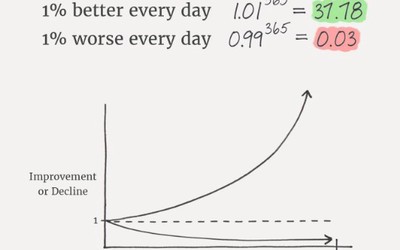
Insights into Chess Visualization Skills
Analyzing Blindfold Chess Survey ResultsWelcome! This post was originally posted on saychess.substack.com back in 2021. The newsletter goes out to +3,700 chess players. New subscribers receive the ebook '100 Headachingly Hard Mate In Two Puzzles Composed By Sam Loyd'.
- Click here to sign up
Analyzing Blindfold Chess Survey Results
In this post, we will look at a survey performed in 2021. The goal of the survey was to get a better understanding of how chess players across ratings visualize the chess board. If you want to solve the exercises before reading further you can do so here: Survey
*Note that I will not use your input, but it might make the post more interesting to read afterward.
The Data
The survey got 165 replies and was beside the newsletter shared on Twitter and on Reddit. The age of the participants looks like this.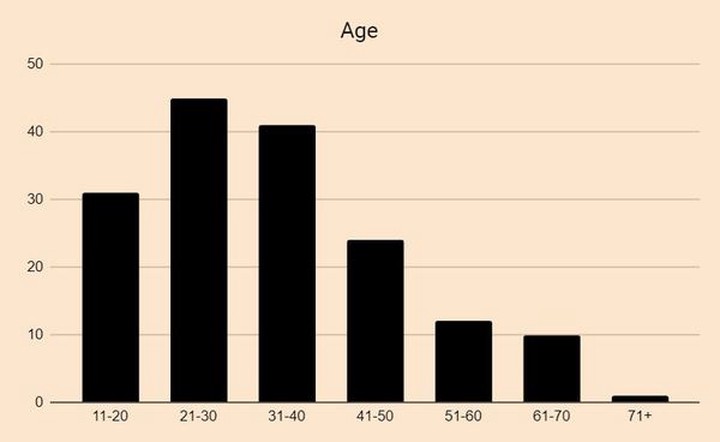
The distribution of the participants with the biggest group between 21-30 years.
And here is the distribution by rating with an even distribution at the higher rating groups. Blindfold chess might scare some beginners off. The rating is based on the Lichess blitz rating (chess.com users were asked to add +200 rating points to that rating).
Participants by rating
First Question: Close your eyes and try to visualize the starting position. What do you “see”?
- 48% answered a 2D board,
- 8% a 3D board,
- 29% saw a blurry image of a board,
- 5% saw something else,
- Lastly, 10% couldn’t visualize anything and saw nothingness/darkness.
If we zoom in on the last question and see it across rating it might be a bit surprising.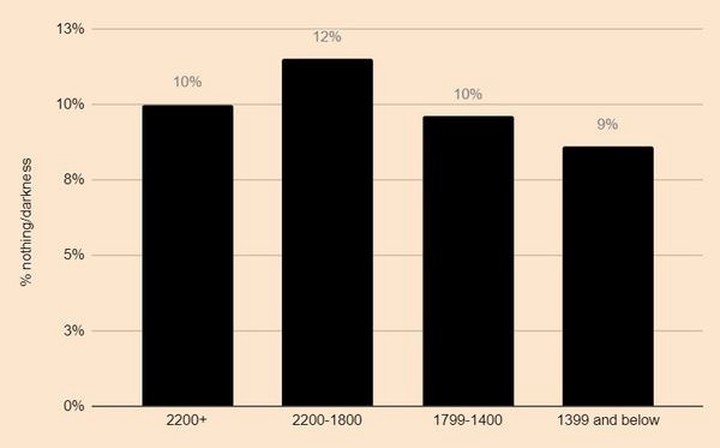
Sees nothingness/darkness
The results indicate that there is an even distribution across ratings of players who can’t create a visual image of the board from the starting position. If we look at the group that either sees a 2D or 3D board it looks like this.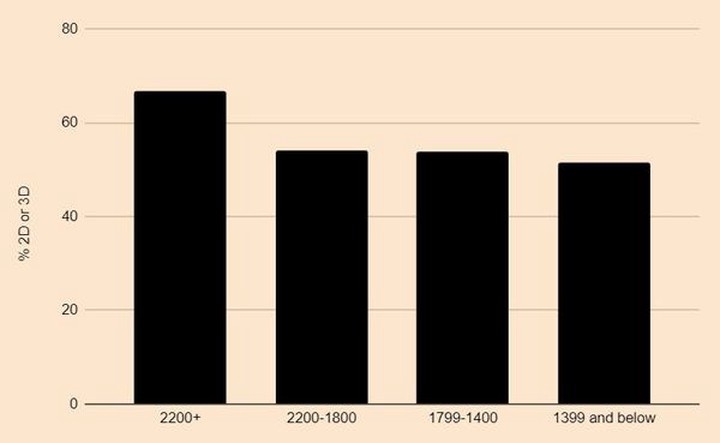
67% of the 2200+ group can produce a mental picture of the starting position while for the other groups only between 51-54% can do this. Now to the next question.
Solve this puzzle: 1. e4 e5 2. Nf3 Nc6 3. Bb5 d6 4. Nc3 Ne7 5. Nd5 g6 (White to move)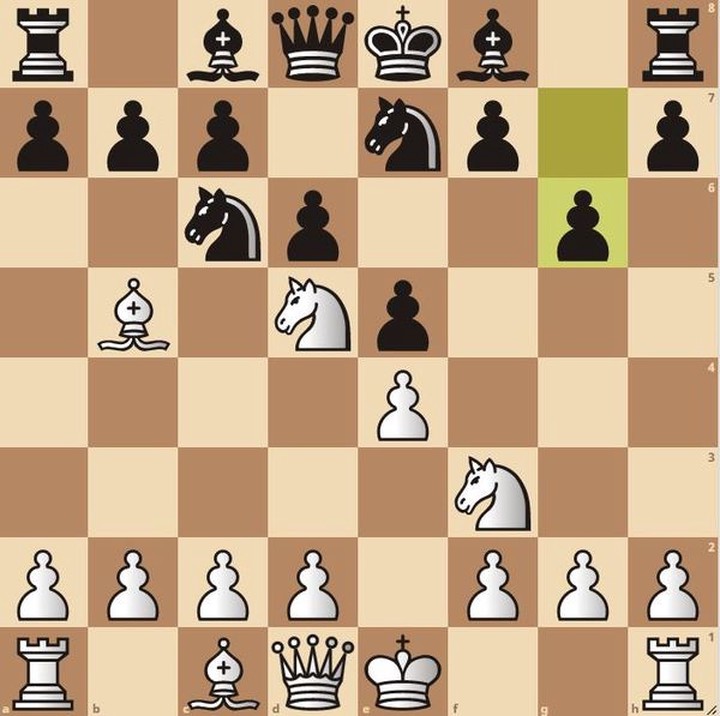
This is how the diagram looks like and was of course not part of the survey.
You will properly quickly spot the solution Nf6#, but blindfolded this was a bit harder for the 165 participants. Let us see how it went.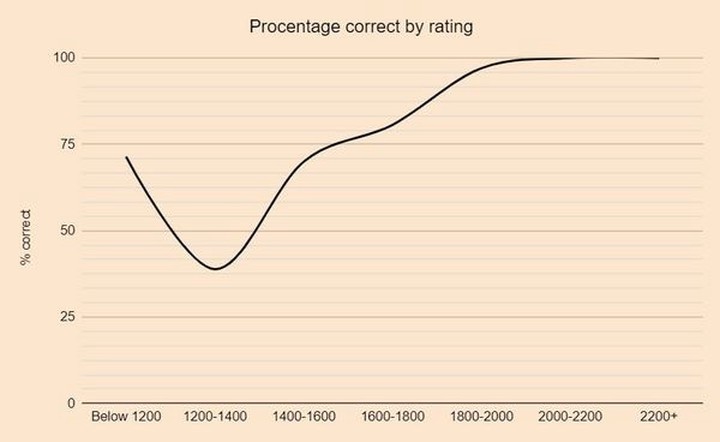
In the small below 1200 group 5 out of 7 got it correct. I don’t think we should make too much of the high performance of this rating group due to the small number.
For the 1200-1400 rated group, only 38% managed to solve the puzzle. If we then move up to 1400-1600 then 70% got it correct. I haven’t created a diagram for how long it took to solve since it is based on the participant’s own experience. However, there was a clear tendency that of those who solved it in the lower rating groups many had to use +4 minutes to do so, while all but two of the +2200 group used more than 60 seconds.
Now it might be interesting to look at how clearly the players across rating judged they could see the position.
How clear (on a scale from 1-5) is your mental picture of the position? (1. e4 e5 2. Nf3 Nc6 3. Bb5 d6 4. Nc3 Ne7 5. Nd5 g6)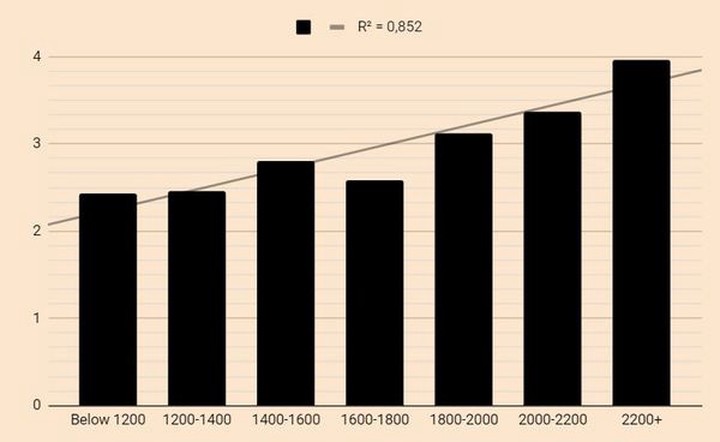
Here it becomes clear that there seems to be a connection between rating and the ability to produce a clear mental picture of a 10-move line. Interestingly there doesn’t seem to be a change in perception before you hit the 1800-2000 rating group. Now let’s move on to the next puzzle.
Try to solve this puzzle. Board Position: White: h4, h5, g6 Black: g7, e5 : g8 - Black to play. Describe how you solved it and the method you used. Also, note your solution.

Black to move
We now have an endgame position with fewer pieces on the board. I guess you instantly want to play Qf6#, but a good share of participants started solving the puzzle for White. Maybe because we are used to having a board to help us decipher a puzzle or just because most studies have White to play.
But let’s take a look at how people solved it:
“I can’t see a win for Black in the pawn ending (and I don’t see why Black is in any way better) so my solution is to force an immediate draw 1...Qe8+ 2. Kg5 Qe5+ 3. Kg4 Qe2+ 4. Kg5 Qe5+ repeating”
Rating: 1800-2000
“Spent 5min with eyes closed visualizing the board reversed. Then realized that the pawns move the other way and found the solution instantly.”
Answer: Qf6#, rating: 1600-1800
“Can’t solve it, I put the pieces on my imaginary board and considered Qxh5 and Qe8+ but couldn’t see how either could work out.”
Rating: Below 1000
“Had to see the board (without pieces) and kept thinking for a while. It took me like 5 min. Even if it was an easy exercise it wasn’t so clear for me.”
Answer: Qf6# rating: 1600-1800
“Grabbed my chess board (but not pieces) and pointed at squares a lot! Somehow managed the previous puzzle without resorting to that, but did check my answer that way afterward.”
Answer: Qf6# rating: 2000-2200
“I "put” the pieces on the board one by one, stopping a second after each one to check its relationship with the pieces already on the board. Then I waste a bit of time thinking that I have to find the move for White cause I’m an idiot.“
Answer: 1...Qf6#. rating: 1800-2000
"Assuming that I’m not allowed to write anything down / use non-visualization tools: first spent a moment making a picture in my head. BQ must move because it’s hanging and unprotectable. The solution could be Qxh5, Kxh5 but KPKP is a draw, but this is a puzzle, so there must be a better solution. It feels to me that the solution is either to trade the BQ for the WQ and wp OR to check the WK until the WQ is hanging. I see that WQ and WK are on the same diagonal, so Qe8+ is a candidate move, but Kg5 offering the trade (and draw) - g6 loses a pawn (and the game), and any BQ move other than Qh5 gives white the initiative, and it’s too difficult to calculate a puzzle answer where white has the initiative, so I assume that Qe8+ is not a solution. Other checks include Q(d/e/f)6+, I can pretend BQ is on a6 for visualization purposes, in which case Kg5 is the only legal move (Bp and BK cut off other squares). After Kg5, the WQ and WK are on the same row, but this isn’t a solution as Qh5 is a repetition. An eventual g6 would be nice to tempo the queen, give the bk room to move, gain space, etc., but g6 Qxg6 Kxg6 leaves white a pawn up to either win or (best case) draw, and we aren’t looking to draw. Thus, we must make a BQ move, and thus figure out whether we are on d, e, or f. If the BQ were on f6, the queen would be protected by the pawn and its checkmate. This took me twenty minutes. I would have seen this about twenty seconds over the board :(”
Answer Qf6#, Rating: 1000-1200
“Qf6 mate. Saw it in my head.”
Rating: 1800-2000
It is interesting to see how this task of visualizing placing 6 pieces on the board can give so many different answers. There was also a clear tendency for the higher-rated players just to note Qf6# as an answer seeing no need to give a method.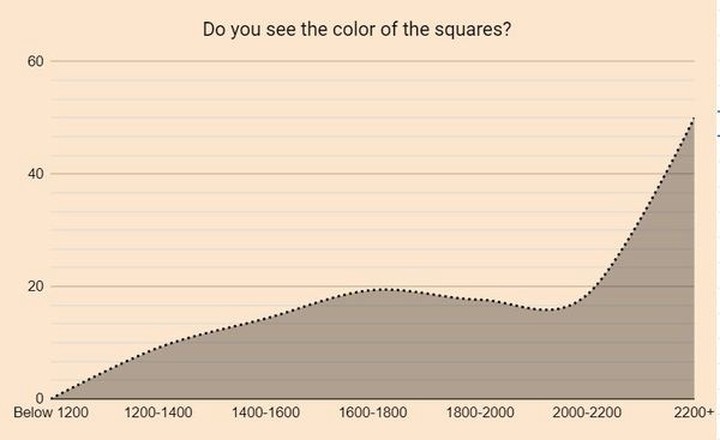
% of people who answered yes
This diagram shows that seeing the colors of the squares (or maybe knowing) is an attribute of the +2200 rated group, where half can do it without applying logic. All of the groups below 1200 had to use logic to find the colors of the squares in puzzle position number two.
Final thoughts
This concludes my small survey. It seems clear to me that the ability to visualize is something that comes with having a higher rating (..or maybe the other way around). If you can gain a higher rating by practicing visualization I don’t know, but it must be an advantage the +2200 group has over the rest of us. The results also suggest that there are different methods to visualize, some might be able to produce strong visual representations of the position while others rely on chess logic to create a diagram of the position.
I hope this survey might inspire others to do more research since we as chess players could benefit from more knowledge about how to practice.
If you found this post interesting you might also want to test your own visualization skills. You can find my two blindfold puzzle books on Amazon.
Link to my newsletter:
- Click here to sign up
/Martin
More blog posts by SayChessClassical
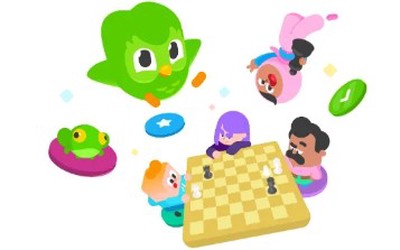
Are Online Chess Players Trapped Pigeons?
The Increasing Gamification of Online Chess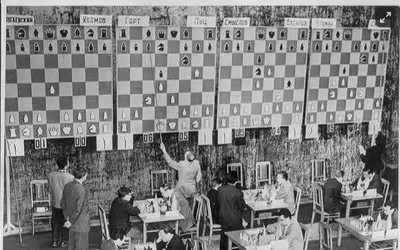
The Great Eval Bar Debate: Chess.com's Broadcasting Style
Should chess tournament broadcast feature an eval bar or not?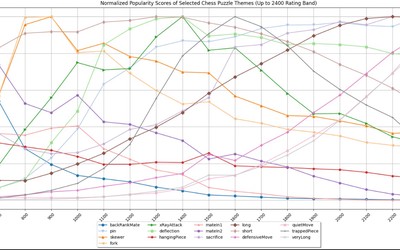
Normalized Popularity Scores of Selected Chess Puzzle Themes on Lichess
The other day I entered into a debate with GM Jacob Aagaard and IM Andras Toth on X about whether ta…